The Strain Rate Sensitivity and Creep Behavior for the Tripler Plane of Potassium Dihydrogen Phosphate Crystal by Nanoindentation
Abstract
:1. Introduction
2. Materials and Methods
3. Results and Discussion
3.1. Strain Rate Sensitivity
3.2. Room-Temperature Creep Behavior
4. Conclusions
Author Contributions
Funding
Acknowledgments
Conflicts of Interest
References
- De Yoreo, J.J.; Burnham, A.K.; Whitman, P.K. Developing KH2PO4 and KD2PO4 crystals for the world’s most power laser. Int. Mater. Rev. 2002, 47, 113–152. [Google Scholar] [CrossRef]
- Hawley-Fedder, R.A.; Geraghty, P.; Locke, S.N.; McBurney, M.S.; Runkel, M.J.; Suratwala, T.I.; Thompson, S.L.; Wegner, P.J.; Whitman, P.K. NIF Pockels cell and frequency conversion crystals. Opt. Eng. Lawrence Livermore Natl. Lab. II Natl. Ignition Facil. 2004, 5341, 121–126. [Google Scholar] [CrossRef]
- Lines, M.E.; Glass, A.M.; Burns, G. Principles and Applications of Ferroelectrics and Related Materials. Phys. Today 1978, 31, 56. [Google Scholar] [CrossRef]
- Blinc, R. Soft modes in ferroelectrics and antiferroelectrics. Ser. Monogr. Sel. Top. Solid State Phys. 1974, 13, 329. [Google Scholar]
- Pritula, I.; Gayvoronsky, V.; Gromov, Y.; Kopylovsky, M.; Kolybaeva, M.; Puzikov, V.; Kosinova, A.; Savvin, Y.; Velikhov, Y.; Levchenko, A. Linear and nonlinear optical properties of dye-doped KDP crystals: Effect of thermal treatment. Opt. Commun. 2009, 282, 1141–1147. [Google Scholar] [CrossRef]
- Li, M.; Chen, M.; Cheng, J.; Xiao, Y.; Jiang, W. Two important mechanisms damaging KH2PO4 crystal processed by ultraprecision fly cutting and their relationships with cutting parameters. Appl. Opt. 2013, 52, 3451–3460. [Google Scholar] [CrossRef] [PubMed]
- Anbukumar, S.; Vasudevan, S.; Ramasamy, P. Microhardness studies of ADP type crystals. J. Mater. Sci. Lett. 1986, 5, 223–224. [Google Scholar] [CrossRef]
- Fang, T.; Lambropoulos, J.C. Microhardness and Indentation Fracture of Potassium Dihydrogen Phosphate (KDP). J. Am. Ceram. Soc. 2004, 85, 174–178. [Google Scholar] [CrossRef] [Green Version]
- Kucheyev, S.O.; Siekhaus, W.J.; Land, T.A.; Demos, S.G. Mechanical response of KD2xH2(1−x)PO4 crystals during nanoindentation. Appl. Phys. Lett. 2004, 84, 2274–2276. [Google Scholar] [CrossRef]
- Xiaoguang, G.; Xiaoji, Z.; Xianzhao, T.; Dongming, G.; Hang, G.; Xiaoji, T. Nanoindentation on the doubler plane of KDP single crystal. J. Semicond. 2013, 34, 034001. [Google Scholar]
- Borc, J.; Sangwal, K.; Pritula, I.; Dolzhenkova, E. Investigation of pop-in events and indentation size effect on the (001) and (100) faces of KDP crystals by nanoindentation deformation. Mater. Sci. Eng. A 2017, 708, 1–10. [Google Scholar] [CrossRef]
- Zhang, Y.; Zhang, L.C.; Liu, M.; Zhang, F.H.; Mylvaganam, K.; Liu, W.D. Revealing the mechanical properties of potassium dihydrogen phosphate crystals by nanoindentation. J. Mater. Res. 2016, 31, 1056. [Google Scholar] [CrossRef]
- Maier-Kiener, V.; Durst, K. Advanced Nanoindentation Testing for Studying Strain-Rate Sensitivity and Activation Volume. JOM 2017, 69, 2246–2255. [Google Scholar] [CrossRef] [Green Version]
- Bach, J.; Stoiber, M.; Schindler, L.; Höppel, H.; Göken, M. Deformation mechanisms and strain rate sensitivity of bimodal and ultrafine-grained copper. Acta Mater. 2020, 186, 363–373. [Google Scholar] [CrossRef]
- Carpenter, J.S.; Misra, A.; Uchic, M.D.; Anderson, P.M. Strain rate sensitivity and activation volume of Cu/Ni metallic multilayer thin films measured via micropillar compression. Appl. Phys. Lett. 2012, 101, 051901. [Google Scholar] [CrossRef]
- Ma, Y.; Ye, J.; Peng, G.; Wen, D.; Zhang, T. Nanoindentation study of size effect on shear transformation zone size in a Ni–Nb metallic glass. Mater. Sci. Eng. A 2015, 627, 153–160. [Google Scholar] [CrossRef]
- Ma, Y.; Feng, Y.; Debela, T.T.; Peng, G.; Zhang, T. Nanoindentation study on the creep characteristics of high-entropy alloy films: Fcc versus bcc structures. Int. J. Refract. Met. Hard Mater. 2016, 54, 395–400. [Google Scholar] [CrossRef] [Green Version]
- Pan, D.; Inoue, A.; Sakurai, T.; Chen, M.W. Experimental characterization of shear transformation zones for plastic flow of bulk metallic glasses. Proc. Natl. Acad. Sci. USA 2008, 105, 14769–14772. [Google Scholar] [CrossRef] [Green Version]
- Ma, Y.; Peng, G.; Debela, T.; Zhang, T. Nanoindentation study on the characteristic of shear transformation zone volume in metallic glassy films. Scr. Mater. 2015, 108, 52–55. [Google Scholar] [CrossRef]
- Weihull, W. A statistical distribution function of wide applicability. J. Appl. Mech. 1951, 18, 290–293. [Google Scholar]
- Ma, Y.; Huang, X.; Song, Y.; Hang, W.; Yuan, J.; Zhang, T. Orientation-Independent Yield Stress and Activation Volume of Dislocation Nucleation in LiTaO3 Single Crystal by Nanoindentation. Materials 2019, 12, 2799. [Google Scholar] [CrossRef] [PubMed] [Green Version]
- Ma, Y.; Peng, G.; Wen, D.; Zhang, T. Nanoindentation creep behavior in a CoCrFeCuNi high-entropy alloy film with two different structure states. Mater. Sci. Eng. A 2015, 621, 111–117. [Google Scholar] [CrossRef]
- Zhang, T.; Ye, J.; Feng, Y.; Ma, Y. On the spherical nanoindentation creep of metallic glassy thin films at room temperature. Mater. Sci. Eng. A 2017, 685, 294–299. [Google Scholar] [CrossRef] [Green Version]
- Choi, I.-C.; Yoo, B.-G.; Kim, Y.-J.; Jang, J.-I. Indentation creep revisited. J. Mater. Res. 2012, 27, 3–11. [Google Scholar] [CrossRef]
- Zhang, Y.; Hou, N.; Zhang, L.-C. Investigation into the room temperature creep-deformation of potassium dihydrogen phosphate crystals using nanoindentation. Adv. Manuf. 2018, 6, 376–383. [Google Scholar] [CrossRef]
- Yang, R.; Zhang, Q.; Xiao, P.; Wang, J.; Bai, Y. Two opposite size effects of hardness at real nano-scale and their distinct origins. Sci. Rep. 2017, 7, 1–8. [Google Scholar] [CrossRef]
- Maier, V.; Schunk, C.; Göken, M.; Durst, K. Microstructure-dependent deformation behaviour of bcc-metals—Indentation size effect and strain rate sensitivity. Philos. Mag. 2014, 95, 1766–1779. [Google Scholar] [CrossRef]
- Bhattacharyya, A.; Singh, G.; Prasad, K.E.; Narasimhan, R.; Ramamurty, U. On the strain rate sensitivity of plastic flow in metallic glasses. Mater. Sci. Eng. A 2015, 625, 245–251. [Google Scholar] [CrossRef]
- Maier, V.; Durst, K.; Mueller, J.; Backes, B.; Höppel, H.W.; Göken, M. Nanoindentation strain-rate jump tests for determining the local strain-rate sensitivity in nanocrystalline Ni and ultrafine-grained Al. J. Mater. Res. 2011, 26, 1421–1430. [Google Scholar] [CrossRef] [Green Version]
- Korte-Kerzel, S. Microcompression of brittle and anisotropic crystals: Recent advances and current challenges in studying plasticity in hard materials. MRS Commun. 2017, 7, 109–120. [Google Scholar] [CrossRef] [Green Version]
- Ma, Y.; Huang, X.; Hang, W.; Liu, M.; Song, Y.; Yuan, J.; Zhang, T. Nanoindentation size effect on stochastic behavior of incipient plasticity in a LiTaO3 single crystal. Eng. Fract. Mech. 2020, 226, 106877. [Google Scholar] [CrossRef]
- Choi, I.-C.; Zhao, Y.; Kim, Y.-J.; Yoo, B.-G.; Suh, J.-Y.; Ramamurty, U.; Jang, J.-I. Indentation size effect and shear transformation zone size in a bulk metallic glass in two different structural states. Acta Mater. 2012, 60, 6862–6868. [Google Scholar] [CrossRef]
- Schuh, C.A.; Lund, A.C. Application of nucleation theory to the rate dependence of incipient plasticity during nanoindentation. J. Mater. Res. 2004, 19, 2152–2158. [Google Scholar] [CrossRef]
- Ma, Y.; Huang, X.; Song, Y. Room-Temperature Creep Behavior and Activation Volume of Dislocation Nucleation in a LiTaO3 Single Crystal by Nanoindentation. Materials 2019, 12, 1683. [Google Scholar] [CrossRef] [PubMed] [Green Version]
- Wang, S.-P.; Xu, J. Incipient plasticity and activation volume of dislocation nucleation for TiZrNbTaMo high-entropy alloys characterized by nanoindentation. J. Mater. Sci. Technol. 2019, 35, 812–816. [Google Scholar] [CrossRef]
- Yu, Y.-L.; Xu, X.-Q.; Lu, C.-D.; Zhang, T.-H.; Ma, Y. Investigation on the microstructural and mechanical properties of a Polytetrafluoroethylene thin film by radio frequency magnetron sputtering. Thin Solid Films 2020, 712, 138302. [Google Scholar] [CrossRef]
- Yu, Y.; Ma, Y.; Huang, X.; Song, Y.; Zhang, T.; Lu, C. Annealing effect on the structure relaxation and mechanical properties of a Polytetrafluoroethylene film by RF-magnetron sputtering. Surf. Coat. Technol. 2021, 405, 126591. [Google Scholar] [CrossRef]
- Ma, Y.; Huang, X.-W.; Hang, W.; Liu, M.; Yuan, J.-L.; Zhang, T.-H. On the delayed incipient plastic deformation in a LiTaO3 single crystal by nanoindentation. J. Phys. D Appl. Phys. 2020, 53, 185303. [Google Scholar] [CrossRef]
- Ma, Y.; Peng, G.J.; Feng, Y.H.; Zhang, T.H. Nanoindentation investigation on creep behavior of amorphous CuZrAl/nanocrystalline Cu nanolaminates. J. Non-Cryst. Solids 2017, 465, 8–16. [Google Scholar] [CrossRef]
- Johnson, K.L.; Keer, L.M. Contact Mechanics. J. Tribol. 1986, 108, 659. [Google Scholar] [CrossRef]
- Huang, Y.; Shen, J.; Chiu, Y.; Chen, J.; Sun, J. Indentation creep of an Fe-based bulk metallic glass. Intermetallics 2009, 17, 190–194. [Google Scholar] [CrossRef]
- Ma, Y.; Song, Y.; Huang, X.; Chen, Z.; Zhang, T. Testing Effects on Shear Transformation Zone Size of Metallic Glassy Films Under Nanoindentation. Micromachines 2018, 9, 636. [Google Scholar] [CrossRef] [PubMed] [Green Version]
- Poisl, W.; Oliver, W.; Fabes, B. The relationship between indentation and uniaxial creep in amorphous selenium. J. Mater. Res. 1995, 10, 2024–2032. [Google Scholar] [CrossRef]
- Zhou, S.; Huang, X.; Lu, C.; Liu, Y.; Zhang, T.; Ma, Y. Revealing the Plastic Mode of Time-Dependent Deformation of a LiTaO3 Single Crystal by Nanoindentation. Micromachines 2020, 11, 878. [Google Scholar] [CrossRef] [PubMed]
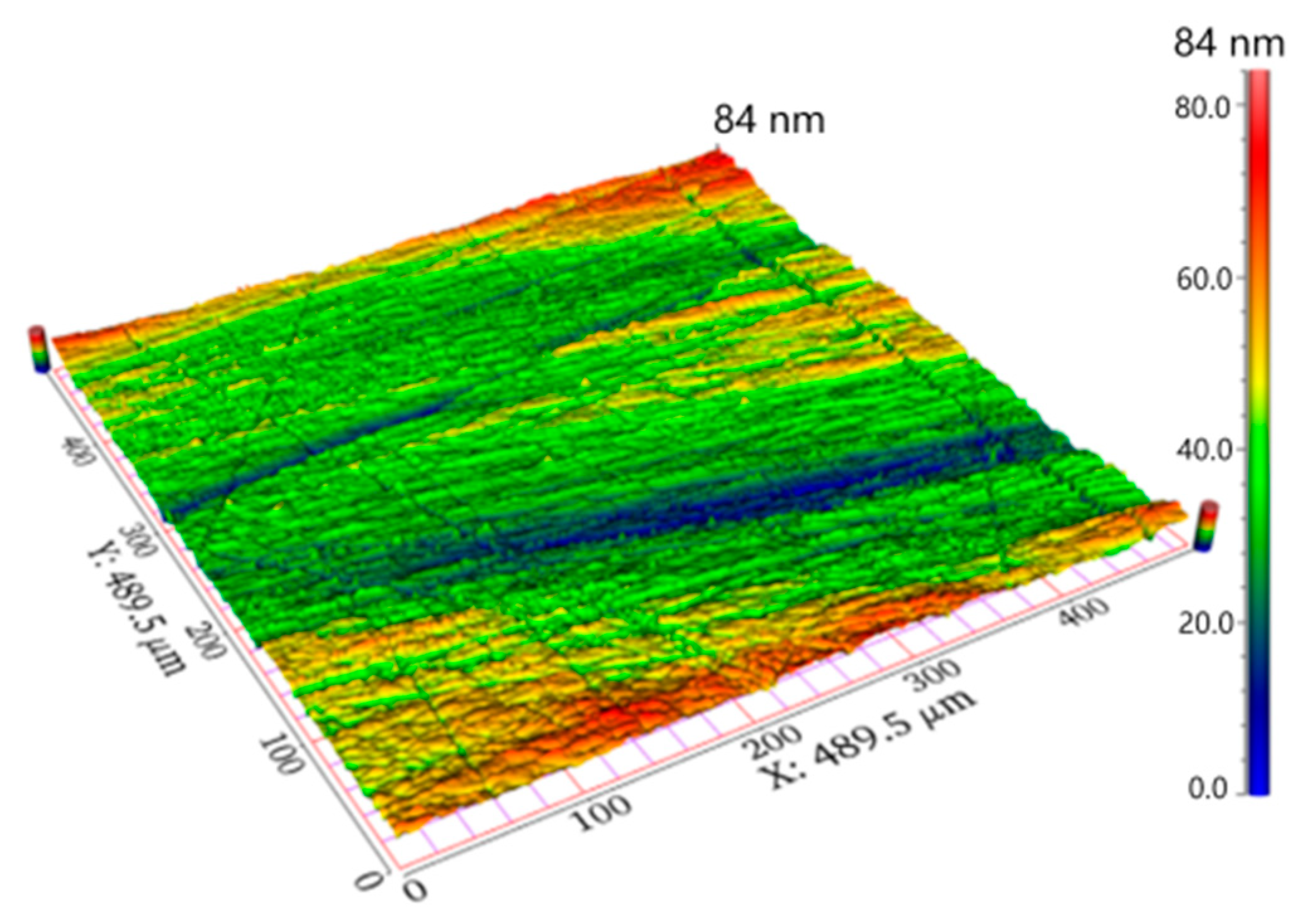

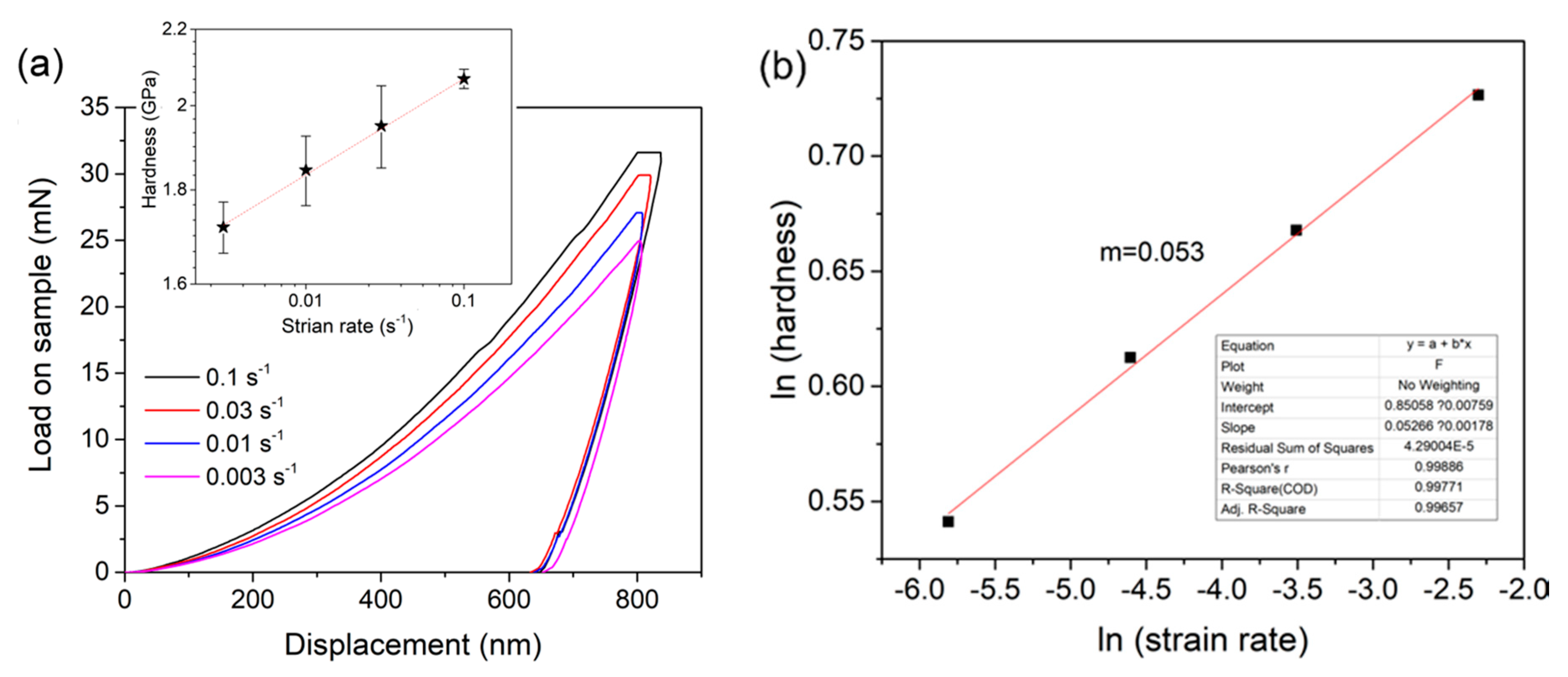
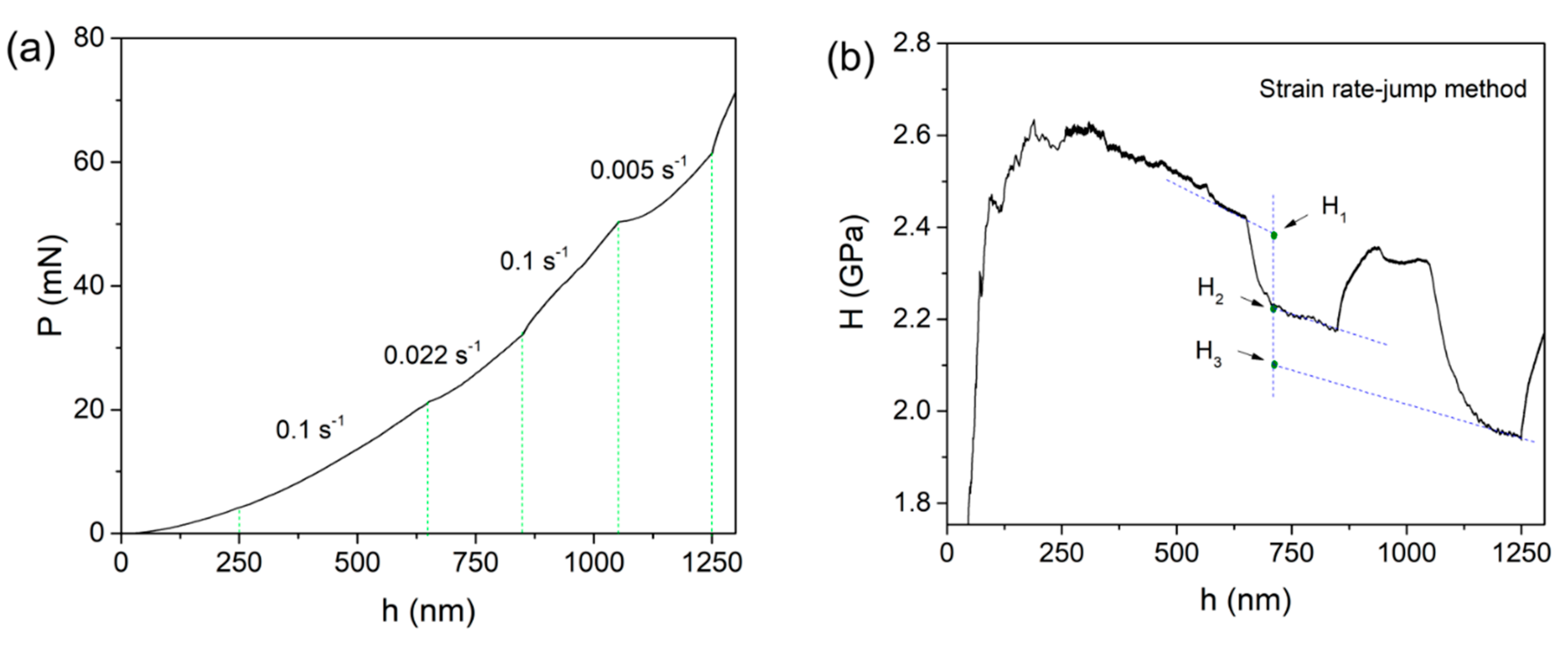
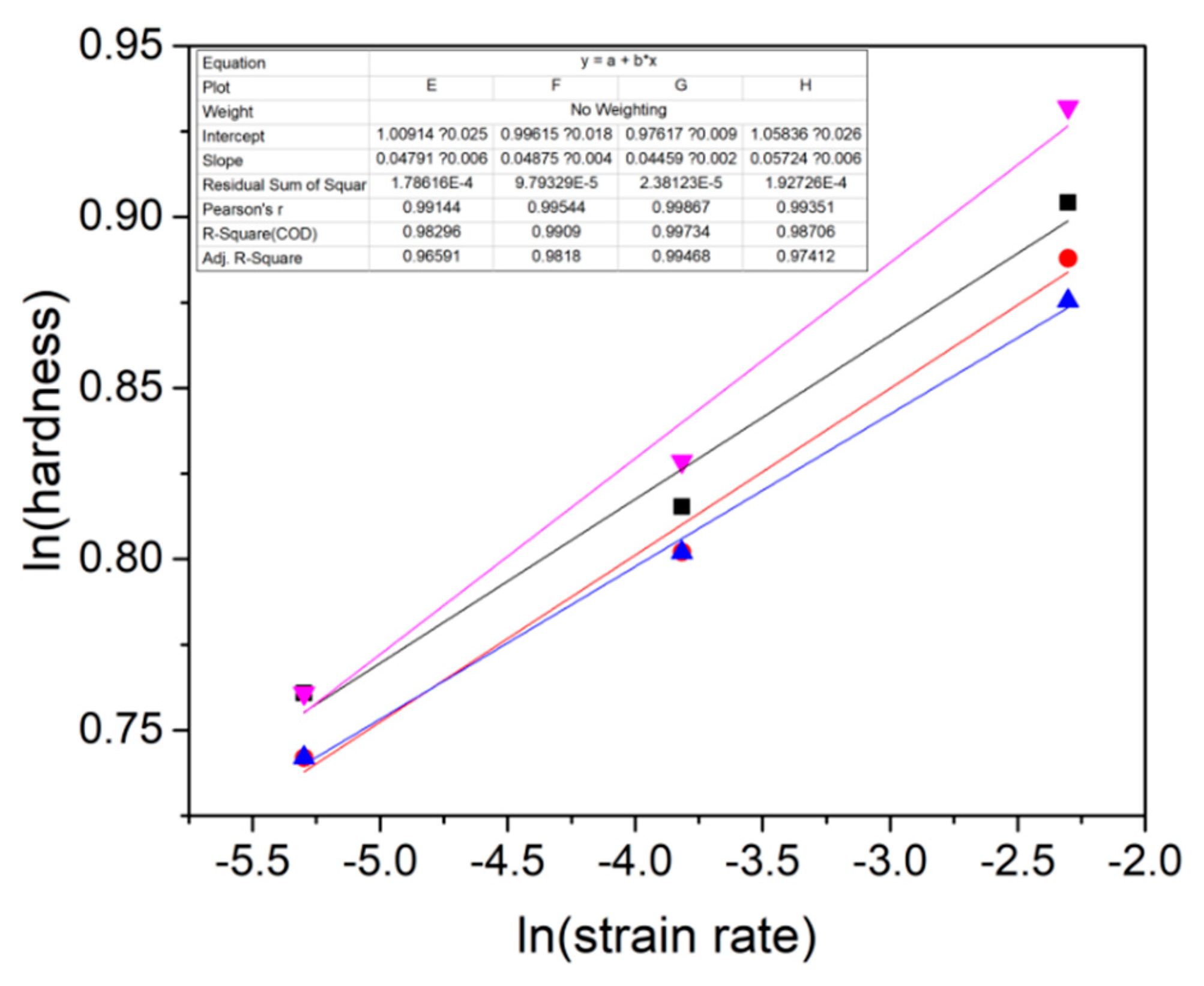



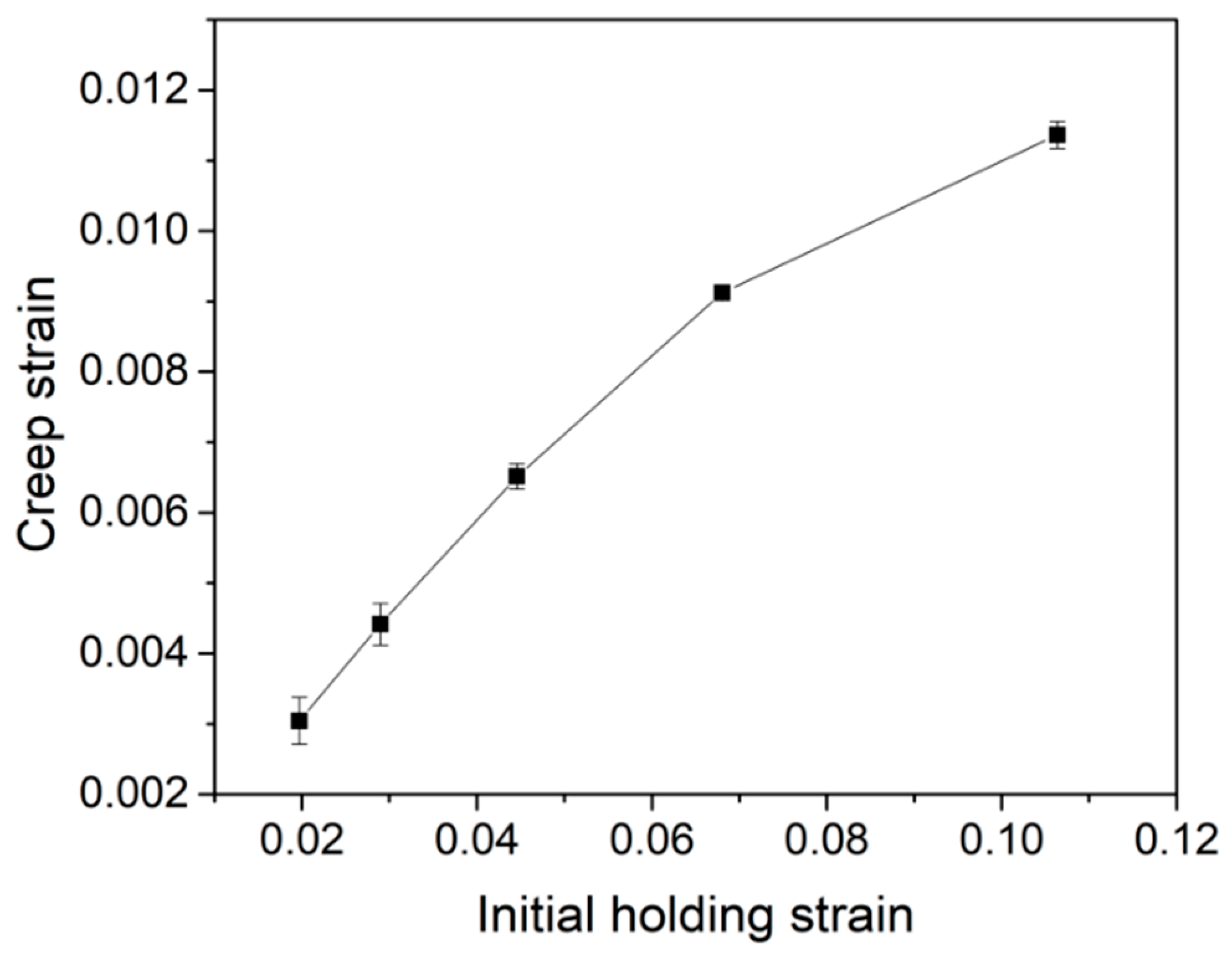


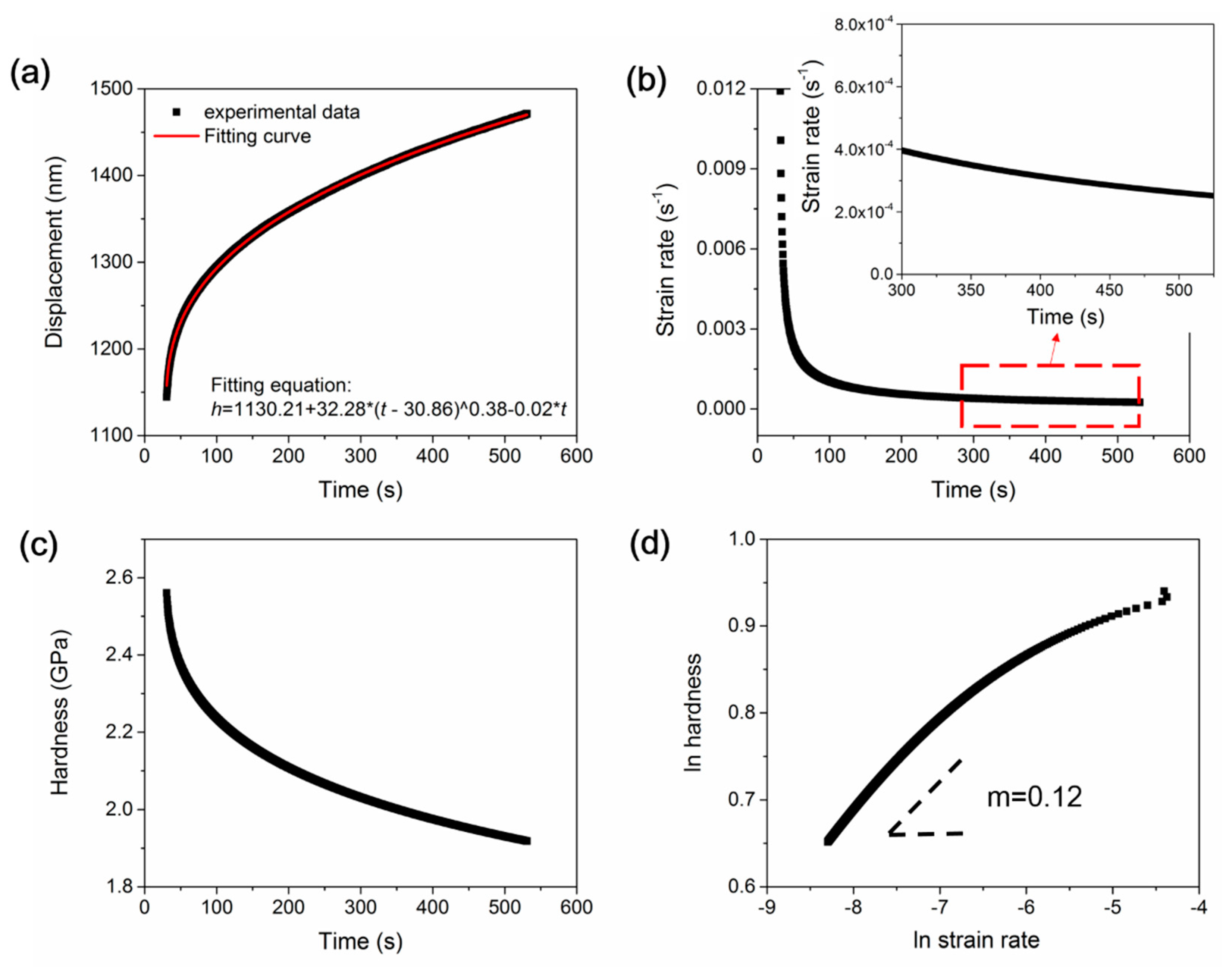
Publisher’s Note: MDPI stays neutral with regard to jurisdictional claims in published maps and institutional affiliations. |
© 2021 by the authors. Licensee MDPI, Basel, Switzerland. This article is an open access article distributed under the terms and conditions of the Creative Commons Attribution (CC BY) license (http://creativecommons.org/licenses/by/4.0/).
Share and Cite
Mao, J.; Liu, W.; Li, D.; Zhang, C.; Ma, Y. The Strain Rate Sensitivity and Creep Behavior for the Tripler Plane of Potassium Dihydrogen Phosphate Crystal by Nanoindentation. Micromachines 2021, 12, 369. https://doi.org/10.3390/mi12040369
Mao J, Liu W, Li D, Zhang C, Ma Y. The Strain Rate Sensitivity and Creep Behavior for the Tripler Plane of Potassium Dihydrogen Phosphate Crystal by Nanoindentation. Micromachines. 2021; 12(4):369. https://doi.org/10.3390/mi12040369
Chicago/Turabian StyleMao, Jianhui, Wenjun Liu, Dongfang Li, Chenkai Zhang, and Yi Ma. 2021. "The Strain Rate Sensitivity and Creep Behavior for the Tripler Plane of Potassium Dihydrogen Phosphate Crystal by Nanoindentation" Micromachines 12, no. 4: 369. https://doi.org/10.3390/mi12040369




